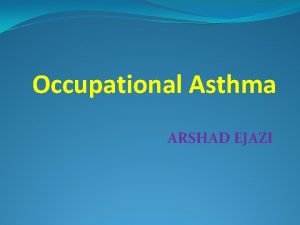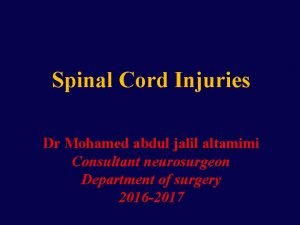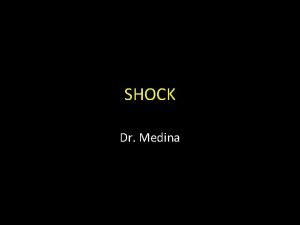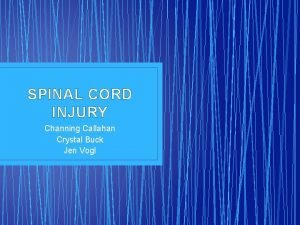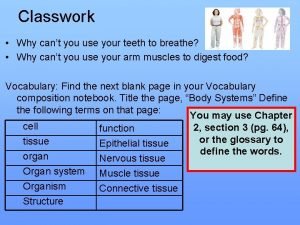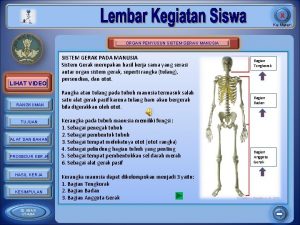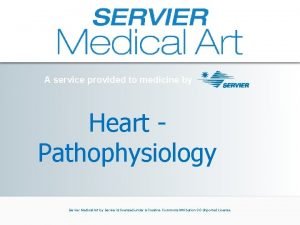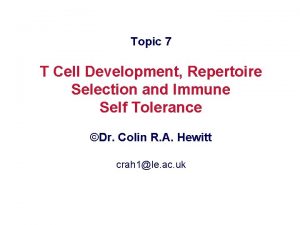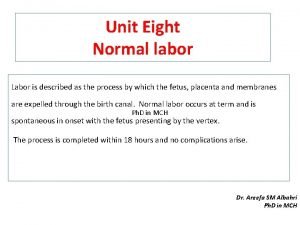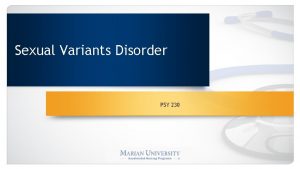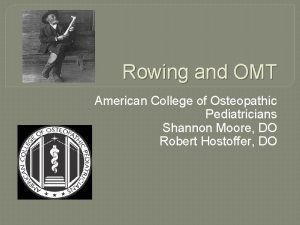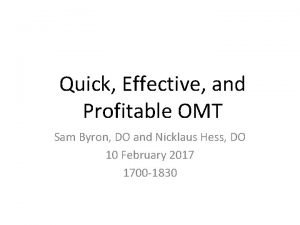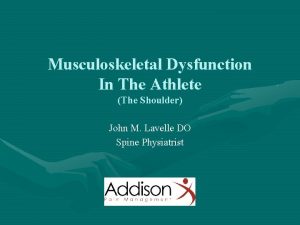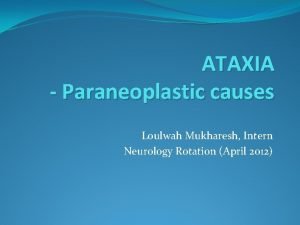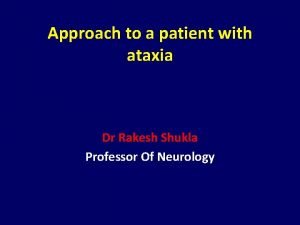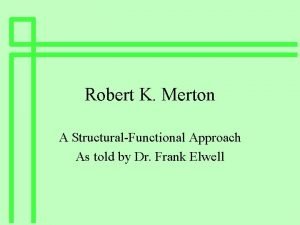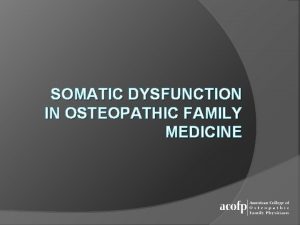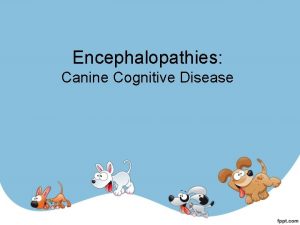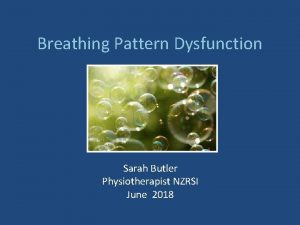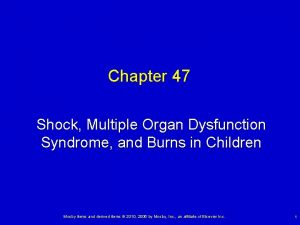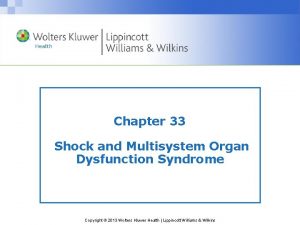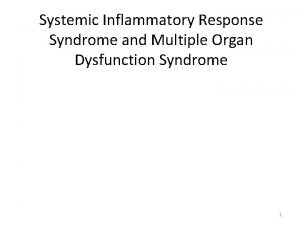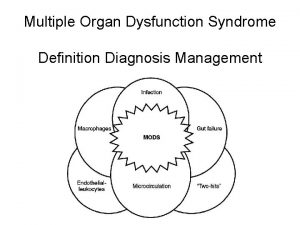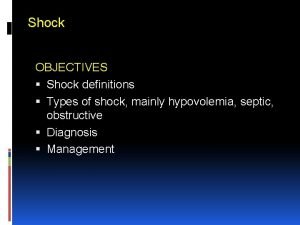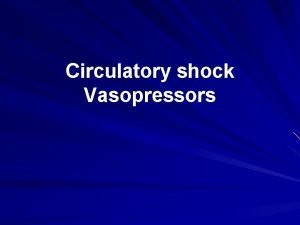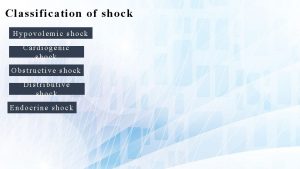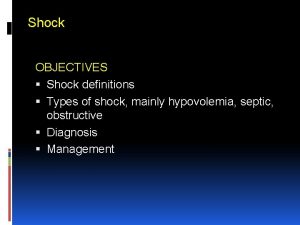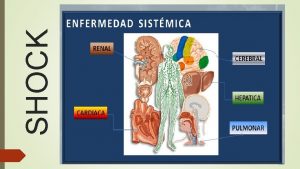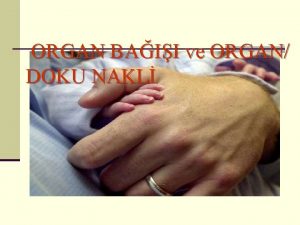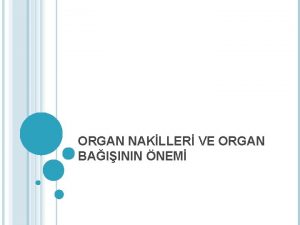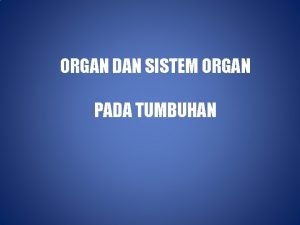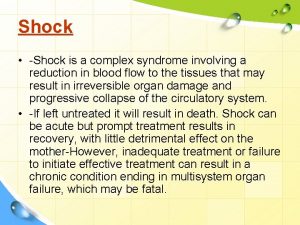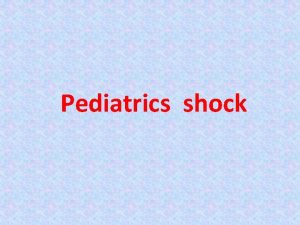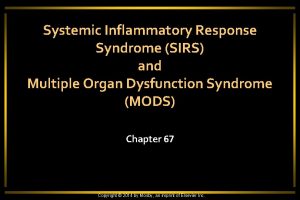Chapter 46 Shock Multiple Organ Dysfunction Syndrome and






























- Slides: 30

Chapter 46 Shock, Multiple Organ Dysfunction Syndrome, and Burns in Adults Mosby items and derived items © 2010, 2006 by Mosby, Inc. , an affiliate of Elsevier Inc. 1

Shock A condition in which the cardiovascular system fails to perfuse the tissues adequately; causes general and widespread impairment of cellular metabolism Many factors cause shock Ø Defective heart function, blood volume changes, or blood vessel changes Mosby items and derived items © 2010, 2006 by Mosby, Inc. , an affiliate of Elsevier Inc. 2

Shock Many causes and clinical manifestations Shock from any cause can progress to organ failure and death Untreated severe shock overwhelms the body’s compensatory mechanisms through positive-feedback loops that initiate and maintain a downward physiologic spiral Mosby items and derived items © 2010, 2006 by Mosby, Inc. , an affiliate of Elsevier Inc. 3

Shock Classified by cause, pathophysiologic process, or clinical manifestations Cardiogenic (caused by heart failure) Ø Neurogenic or vasogenic (alterations in smooth muscle tone) Ø Anaphylactic (hypersensitivity) Ø Septic (caused by infection) Ø Hypovolemic (insufficient intravascular fluid) Ø Traumatic (components of hypovolemic and septic) Ø Mosby items and derived items © 2010, 2006 by Mosby, Inc. , an affiliate of Elsevier Inc. 4

Shock Patient complaints Ø Weak, “feeling sick, ” cold, hot, nauseated, dizzy, confused, afraid, thirsty, short of breath Blood pressure, cardiac output, and urinary output are usually decreased; the respiratory rate is usually increased Treatment: correct or remove underlying cause and provide supportive therapy Mosby items and derived items © 2010, 2006 by Mosby, Inc. , an affiliate of Elsevier Inc. 5

Shock Impairment of cellular metabolism Ø Impaired oxygen use regardless of cause • Aerobic to anaerobic metabolism • Lose ability to maintain electrochemical gradient • Sodium and chloride accumulate in the cell Water follows, thus reducing the extracellular volume • Potassium exits the cell • Activated positive-feedback loops impair further oxygen use Coagulation pathway activation, decreased circulatory volume, lysosomal enzyme release Mosby items and derived items © 2010, 2006 by Mosby, Inc. , an affiliate of Elsevier Inc. 6

Shock Impaired cellular metabolism Ø Impaired glucose use • Delivery or uptake • Cells shift to glycogenolysis, gluconeogenesis, lipolysis • Gluconeogenesis causes proteins to be used for fuel, thus are no longer available to maintain cellular structure, function, repair, and replication Toxic ammonia and urea production • Metabolic acidosis Compensatory mechanism initiated: enables cardiac and skeletal muscles to use lactic acid as a fuel source but only for limited time Mosby items and derived items © 2010, 2006 by Mosby, Inc. , an affiliate of Elsevier Inc. 7

Shock Cardiogenic (heart failure) Cause: myocardial ischemia, MI, CHF, myocardial or pericardial infections, dysrhythmias, and drug toxicity Ø Clinical manifestations caused by inadequate perfusion to the heart and end organs Ø As cardiac output decreases, compensatory adaptive responses activated: renin-angiotensin, neurohormonal, and sympathetic nervous systems • Cause fluid retention, systemic vasoconstriction, tachycardia Ø Catecholamines increase contractility and heart rate Ø Further stress and metabolic demands on failing heart Ø Mosby items and derived items © 2010, 2006 by Mosby, Inc. , an affiliate of Elsevier Inc. 8

Cardiogenic Shock Mosby items and derived items © 2010, 2006 by Mosby, Inc. , an affiliate of Elsevier Inc. 9

Shock Hypovolemic Insufficient intravascular fluid volume Ø Loss of whole blood, blood plasma, interstitial fluid, or fluid sequestration • Hemorrhage or burns Ø Compensatory vasoconstriction, increased SVR, and afterload to improve blood pressure and perfusion to core organs Ø If these mechanisms fail, impaired nutrient delivery and failing cellular metabolism Ø Mosby items and derived items © 2010, 2006 by Mosby, Inc. , an affiliate of Elsevier Inc. 10

Hypovolemic Shock Mosby items and derived items © 2010, 2006 by Mosby, Inc. , an affiliate of Elsevier Inc. 11

Shock Neurogenic (vasogenic) Widespread vasodilation from imbalance between parasympathetic and sympathetic simulation Ø Causes persistent vasodilation and creates relative hypovolemia • Blood volume unchanged, but amount of space Ø containing the blood has increased, so SVR decreases drastically • Pressure in vessels is inadequate to drive nutrients across capillary membranes; nutrient delivery to cells is impaired Ø Severe pain and stress, anesthesia, and depressant drugs Mosby items and derived items © 2010, 2006 by Mosby, Inc. , an affiliate of Elsevier Inc. 12

Neurogenic Shock Mosby items and derived items © 2010, 2006 by Mosby, Inc. , an affiliate of Elsevier Inc. 13

Shock Anaphylactic Allergen causes extensive immune and inflammatory response Ø Widespread hypersensitivity reaction leading to vasodilation, peripheral pooling, relative hypovolemia Ø Extravascular effects include constriction of extravascular smooth muscle • Constriction often causes respiratory difficulty Ø More severe due to other pathophysiologic effects Ø Mosby items and derived items © 2010, 2006 by Mosby, Inc. , an affiliate of Elsevier Inc. 14

Anaphylactic Shock Mosby items and derived items © 2010, 2006 by Mosby, Inc. , an affiliate of Elsevier Inc. 15

Shock Septic Infectious processes initiate septic shock Ø Six most common infection sites: lungs, bloodstream, intravascular catheter, intra-abdominal, urinary tract, surgical wound Ø Bacteremia, endotoxins, and exotoxins cause the host to initiate the inflammatory process • Complement, coagulation, kinin, and cellular immunity Ø The inflammatory response initiates and promotes widespread vasodilation Ø Symptoms similar to neurogenic/anaphylactic shock Ø Mosby items and derived items © 2010, 2006 by Mosby, Inc. , an affiliate of Elsevier Inc. 16

Multiple Organ Dysfunction Syndrome (MODS) Progressive dysfunction of two or more organ systems due to an uncontrolled inflammatory response to a severe illness or injury Shock and sepsis are the most common causes, but can be from any injury or disease that initiates massive systemic inflammation Ø Trauma, major surgery, burns, acute pancreatitis, acute renal failure, ARDS Mosby items and derived items © 2010, 2006 by Mosby, Inc. , an affiliate of Elsevier Inc. 17

Multiple Organ Dysfunction Syndrome (MODS) 54% mortality rate if two organ systems are affected Mortality rate increases to 100% with five systems failing Mosby items and derived items © 2010, 2006 by Mosby, Inc. , an affiliate of Elsevier Inc. 18

Multiple Organ Dysfunction Syndrome (MODS) Secondary MODS Progressive organ dysfunction Ø Result of excessive inflammatory reaction after a latent period following the initial injury, in organs distant from the site of the original injury Ø Thought that the resulting organ trauma is caused by the host response to a second insult rather than being a direct result of the primary injury • Second insult mild but produces immense disproportionate Ø response because of the previous priming of leukocytes • Interaction of injured organs leads to a self-perpetuating inflammation Mosby items and derived items © 2010, 2006 by Mosby, Inc. , an affiliate of Elsevier Inc. 19

Multiple Organ Dysfunction Syndrome (MODS) Maldistribution of blood flow Hypermetabolism Myocardial depression Supply-dependent oxygen consumption Reperfusion injury Mosby items and derived items © 2010, 2006 by Mosby, Inc. , an affiliate of Elsevier Inc. 20

Multiple Organ Dysfunction Syndrome (MODS) Treatment Control initial inflammatory process Ø Restore intravascular volume Ø Aimed at providing oxygen and nutrition to support failing organs Ø Mosby items and derived items © 2010, 2006 by Mosby, Inc. , an affiliate of Elsevier Inc. 21

Burns General term describing cutaneous injury due to thermal, chemical, or electrical causes Multisystem injuries with interaction of shock, inflammation, immunocompromise Burns can be thermal or nonthermal Mosby items and derived items © 2010, 2006 by Mosby, Inc. , an affiliate of Elsevier Inc. 22

Burns Burn wound depth First-degree burns • Partial-thickness injury Ø Second-degree burns • Superficial partial-thickness injury • Deep partial-thickness injury Ø Third-degree burns • Full-thickness injury • Painless because nerve endings destroyed Ø Mosby items and derived items © 2010, 2006 by Mosby, Inc. , an affiliate of Elsevier Inc. 23

Burns Mosby items and derived items © 2010, 2006 by Mosby, Inc. , an affiliate of Elsevier Inc. 24

Burn Injury Total body surface area (TBSA) Ø Rule of nines Burn injury severity is a combination of age, medical history, extent and depth of injury, and body area involved Mosby items and derived items © 2010, 2006 by Mosby, Inc. , an affiliate of Elsevier Inc. 25

Rule of Nines Mosby items and derived items © 2010, 2006 by Mosby, Inc. , an affiliate of Elsevier Inc. 26

Burn Injury Burn shock Hypovolemic shock Ø Decreased cardiac contractility Ø Cellular response Metabolic response Immunologic response Evaporative water loss Mosby items and derived items © 2010, 2006 by Mosby, Inc. , an affiliate of Elsevier Inc. 27

Burn Injury Burn shock Ø Massive edema associated with burn shock is inevitable with fluid resuscitation • Failure to administer resuscitation fluid results in irreversible hypovolemic shock and death Edema in unburned as well as burned areas Ø Edema often leads to mechanical airway obstruction; necessitates tracheal intubation, and increased severity of the interstitial pulmonary edema associated with inhalation injury Ø Mosby items and derived items © 2010, 2006 by Mosby, Inc. , an affiliate of Elsevier Inc. 28

Burn Shock Mosby items and derived items © 2010, 2006 by Mosby, Inc. , an affiliate of Elsevier Inc. 29

Burn Shock Mosby items and derived items © 2010, 2006 by Mosby, Inc. , an affiliate of Elsevier Inc. 30
 Occupational asthma
Occupational asthma Cauda equina vs conus medullaris
Cauda equina vs conus medullaris Shock normovolemico
Shock normovolemico Spinal shock vs neurogenic shock
Spinal shock vs neurogenic shock Spinal shock vs neurogenic shock
Spinal shock vs neurogenic shock Spinal shock vs neurogenic shock
Spinal shock vs neurogenic shock Organ and organ system
Organ and organ system Cell tissue organ organ system organism
Cell tissue organ organ system organism Cells are the building blocks of all living things
Cells are the building blocks of all living things Organ berikut yang merupakan penyusun sistem gerak adalah
Organ berikut yang merupakan penyusun sistem gerak adalah Foto rontgen efusi pleura
Foto rontgen efusi pleura Penyusun sistem saraf pusat adalah
Penyusun sistem saraf pusat adalah Systolic and diastolic dysfunction
Systolic and diastolic dysfunction Dengue shock syndrome
Dengue shock syndrome Where does negative selection occur
Where does negative selection occur What is the transition phase of labor
What is the transition phase of labor Orgasmic dysfunction
Orgasmic dysfunction Rib raising omt
Rib raising omt Orthomode transducer tutorial
Orthomode transducer tutorial Rib somatic dysfunction
Rib somatic dysfunction Hypertonic vs hypotonic uterine dysfunction
Hypertonic vs hypotonic uterine dysfunction Conjunction dysfunction meaning
Conjunction dysfunction meaning Loulwah mukharesh
Loulwah mukharesh Romberg test positive causes
Romberg test positive causes Robert k merton structural functionalism
Robert k merton structural functionalism Ivrt echo
Ivrt echo Urt
Urt Pelvic floor dysfunction
Pelvic floor dysfunction Judy ritchie
Judy ritchie Impaired mentation
Impaired mentation Breathing pattern dysfunction
Breathing pattern dysfunction
